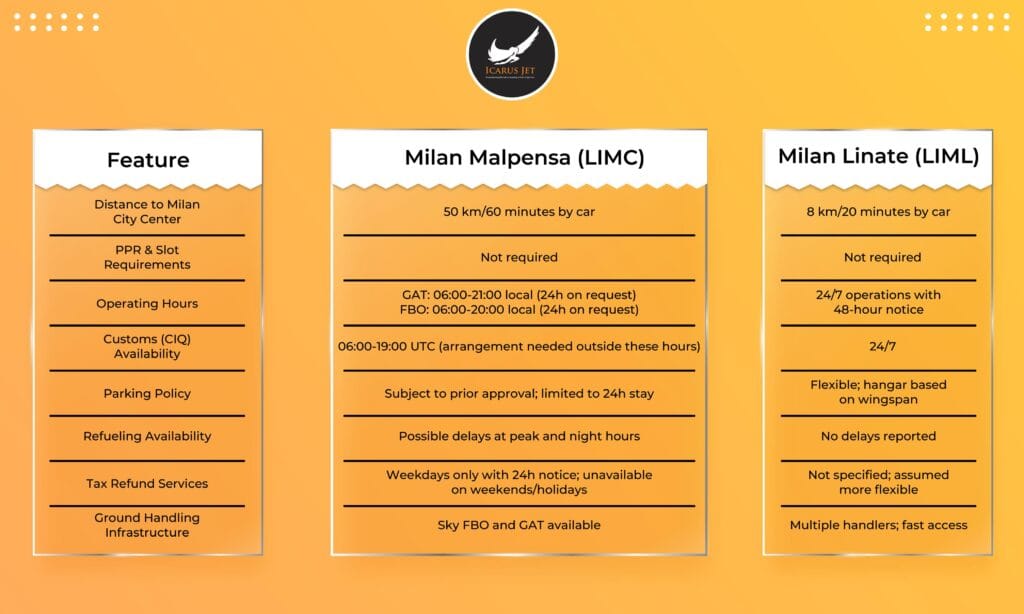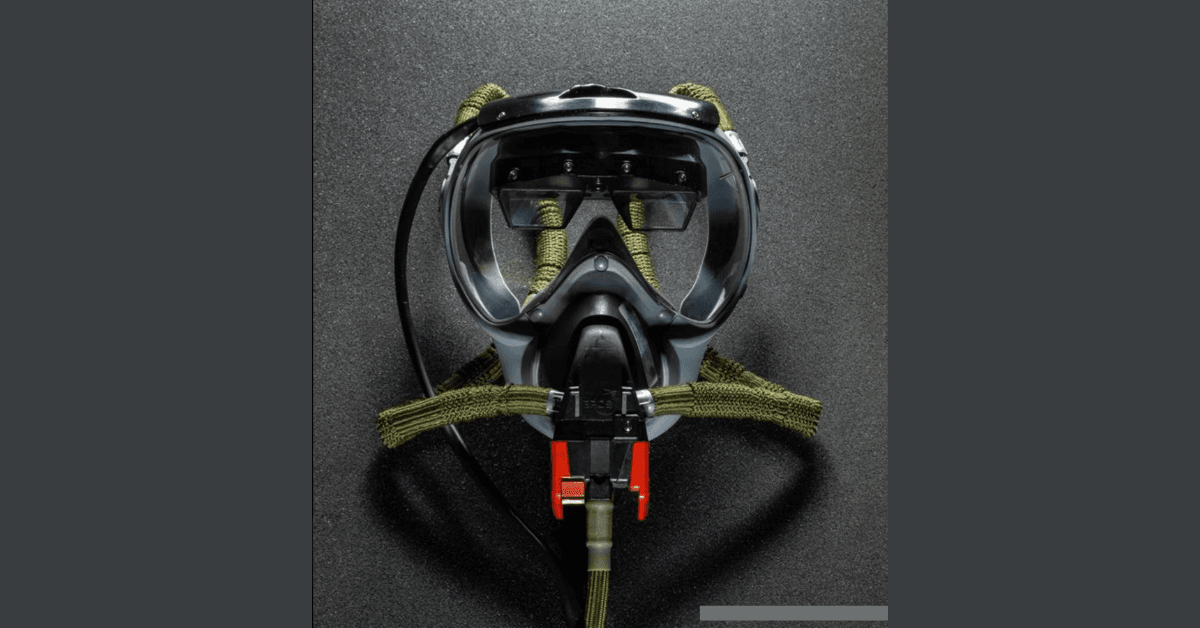Private jet flights into Milan in Italy need planning to avoid delays and to achieve a quick turnaround. The city has two international airports: Milan Malpensa (LIMC) and Milan Linate (LIML). Both airports have general aviation handling facilities, but their procedures, facilities, and efficiency are quite different.
Our trip support team has prepared an in-depth comparison intended for private jet crews, operators, and dispatchers, who require accurate, high-quality information to establish the most appropriate airport when flying in the Milan region.
General Overview

Operational flexibility
Linate (LIML) offers unparalleled flexibility for business jet flights. Featuring completely unrestricted 24/7 access, no PPR or slot necessities, and all customs and immigration facilities available 24/7, the airport is established to accommodate high-frequency business aviation without procedural delays. The access is satisfactory with simple 48-hour advance notice.
Conversely, Malpensa (LIMC), while not requiring PPR or slots, is more restrictive. GAT and FBO facilities are time-restricted unless pre-booked, and the customs availability is for a shorter time window, which requires advanced coordination for arrival or departure outside these times.
Access to Milan: Distance and ground transfer time
Milan Linate is about 8 kilometers from the city center, a 15- to 25-minute drive in normal traffic conditions. It is very convenient for fast turnarounds, business flights, or missions that need to access Milan’s central areas without losing time.
Milan Malpensa, on the other hand, is roughly 50 kilometers from the city center, equating to 50 to 70 minutes by road, traffic permitting. The longer distance not only imposes passengers and crew to extended travel times but also makes last-minute changes or rapid redeployments more challenging.
For corporate jet flights where closeness to the city is an aspect, for example executive meetings, events, or crew overnight stays, Linate provides a much shorter and more convenient ground segment.
Parking and slot management
A further discriminator between the two airports is parking. LIML is quite receptive to parking access, and hangar space is allocated based on schedule and wingspan of the aircraft. The policy is flexible for longer stays or late schedule changes, although in peak season and during events like the Design Week in Milan, congested is high and the need to consider alternatives is paramount.
LIMC, on the other hand, needs prior permission for parking. Every request is examined on a case-by-case basis depending on aircraft type and planned duration of stay. Overnight or long-term parking is not favored, and relocation to out-of-the-way stands is a possibility. Notably, no extension of parking stay will be allowed once authorized, placing operators with delays or longer-than-expected layovers at logistical risk.
Furthermore, efficiency in fueling is another major driver of turnaround time. LIML currently records no delays or limitations in fuel supply, making it highly suitable for high-tempo operations and quick turns.
LIMC will take delivery from various suppliers such as CARBOIL, LEVORATO, and SkyServices, with releases and carnets acceptance in general. Delays can be expected during peak seasons or at nighttime, especially those beyond the control of the handling agent.
Customs, tax, and passenger processing
Linate’s customs, immigration, and quarantine (CIQ) services are active around the clock, supporting seamless international entries and exits at any time.
Malpensa has customs and financial police facilities available from 06:00 to 19:00 UTC, with outside cover only by prior arrangement. Tax refund facilities are available Monday to Friday, 09:00 to 17:00 local time, and need 24-hour notice. A refund on weekends or public holidays is not available, which can affect passenger experience.
Crew support and logistics
Linate has the benefit of proximity to Milan’s downtown area, with easier crew transfers and access to city amenities. Ground handling is efficient, and operator logistics are straightforward.
Malpensa crews can anticipate more complexity. Local law does not allow for direct taxi reservation to and from the Sheraton Hotel. A private van service is available but requires prior notice of at least 24 hours. Laundry and dishwashing services require long lead times – typically one or two business days –and therefore make LIMC less convenient for short or unplanned stops.
The verdict: Which airport is best for private jet operations?
For private jet operators who are time-conscious and prefer control over operations and predictability of turnaround, Milan Linate (LIML) is the clear winner. With unrestricted customs access, 24/7 operations, and guaranteed fueling, it is the more practical and flexible option for general aviation flights.
Milan Malpensa (LIMC), while being a productive airport with full FBO amenities, faces parking limitations, limited customs availability, and occasional delays that reduce its attractiveness for high-efficiency business aviation flight movements. It is also further away from the city center.
Crews and operators who want to reduce delays and have optimum scheduling flexibility should put Linate (LIML) at the top of their list when planning Milan private jet flights. It is the operationally preferred airport and enables quicker, easier mission completion.
Malpensa (LIMC) is still a possibility for flights with particular operational requirements or if Linate is not available, though it needs more precise pre-planning because it has stricter limitations and less flexibility. Either way, our trip support team can help you plan every detail for your next flight.
FAQs
1. Which Milan airport is closer to the city center for private jet flights?
Milan Linate (LIML) is nearer, about 8 km from the city center with a 15–25-minute normal drive. Milan Malpensa (LIMC) is approximately 50 km from the city center and takes a 50–70-minute drive by car, traffic permitting.
2. Do I need a slot or PPR to operate a private jet at LIMC or LIML?
No. Neither Linate (LIML) nor Malpensa (LIMC) is subject to slot coordination or Prior Permission Required (PPR) for general aviation. LIMC does, however, require parking permission from airport authorities for overnight stays of private jets of any duration.
3. Which Milan airport is more efficient for quick turnarounds?
Linate (LIML) is typically the more time-saving choice. It has 24/7 operations with complete customs availability throughout the day, quick access to Milan city center, and no fuel delays. Malpensa can experience operational drag because of limited customs hours of operation, parking constraints, and possible fueling delays at peak periods.
4. Are there any parking or hangar limitations at either airport?
Parking is possible at Linate, and hangar space is allocated based on wingspan and schedule. Malpensa, nevertheless, requires individual approval for parking for each request. Parking in excess of 24 hours may require repositioning, and no extension of parking time can be permitted.
5. Is fuel easily accessible at both LIMC and LIML?
Linate (LIML) has unlimited fuel availability with no reported delay and thus is better suited for short-notice or high-frequency operations. Malpensa (LIMC) has several fuel agents, though crews can anticipate possible delays during peak and evening hours, particularly during times of peak demand.
Update for Pilots and Operators – 07.11.25
Milan’s two primary airports, Linate (LIML) and Malpensa (LIMC), have drastically increased parking charges for business aviation. A 50-ton aircraft parked for three days now pays approximately €3,180 at Linate and €2,220 at Malpensa—up from a few hundred euros. Regional airports such as Parma (LIMP), Brescia (LIPO), and Bergamo (LIME) continue to have lower costs and fewer restrictions, and could be worth using for repositioning or even passenger drop-offs, depending on the route.




